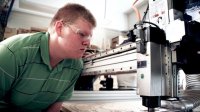Integrated Projects = Deeper Learning
Here’s how one school designs rigorous projects that blend STEM with other core subjects. See how this strategy might work for you.
Your content has been saved!
Go to My Saved Content.MC2 (Metropolitan Cleveland Consortium) STEM High School is a year-round public school in Cleveland, Ohio. The school was created through a public-private partnership among a number of organizations (PDF), with the intention of providing students with an integrated curriculum that is informed by real-world experiences. Since MC2 STEM opened in 2008, 95 percent of their students have graduated and 84 percent of their graduates have matriculated to college.
The MC2 STEM curriculum was designed to meet three important criteria:
- aligned with Ohio Academic Content Standards
- connected to higher-education courses
- relevant and responsive to industry needs
What is Transdisciplinary Project-Based Learning?
To meet these objectives, the curriculum was mandated to be transdisciplinary -- meaning across academic subjects as well as across school and nonschool settings (e.g., internships (PDF)) -- and was developed by work groups that included representatives from STEM-related industries, postsecondary education, and preK-12 education.
The PBL instruction (PDF) at MC2 STEM is built on rigorous ten-week projects called capstones (PDF). Though the focus is STEM, the capstones integrate all core subjects required by Ohio's state standards. Each capstone is organized around a theme, such as light, and covers topics mapped to state benchmarks. They are broken into transdisciplinary units, each of which has a rubric (PDF) and one to two student deliverables for assessment. Units in the capstone about light cover concepts including fractals, electric circuitry, human biology, and principles of design. Rubrics are transparent to the students as well so that they know exactly what is required for mastery (PDF).
Importantly, all capstones have real-world relevance (PDF). They focus on themes related to energy and sustainability, and are timely, based on current issues that the STEM industry is facing. Some project deliverables are put into actual use in the community as well, such as last year's project in which snow flakes with designs based on fractal geometry were hung downtown.
How To Design Integrated Projects
Catherine Staveteig, a math teacher at MC2 STEM, described the teachers' collaborative project-development process (PDF):
- Brainstorm a list of potential capstone themes that relate to energy and sustainability.
- Identify benchmarks that need to be covered that quarter in each subject area.
- Map benchmarks to capstone themes.
- Select capstone themes that cover the most benchmarks.
- Decide what kind of product the students will produce to demonstrate their mastery of the benchmarks.
- Working backward from the final product, break it down into skills students will need for the project.
- Create a calendar that will allow time for kids to work collaboratively with each other and across subjects, and for teachers to teach subject-specific skills.
Resources from MC2 STEM
(Read about the mastery assessment system at MC2 STEM High School and how they provide real-world opportunities for their students)
What do you think about this Schools That Work story? We'd love to hear from you!
Tweet your answer to @edutopia, comment below, or email us.
Mc2 Stem High School
Enrollment
270 | Public, UrbanPer Pupil Expenditures
$10406 School • $15072 District • $10571 StateFree / Reduced Lunch
100%DEMOGRAPHICS:
12% individualized education programs
2% English-language learners
